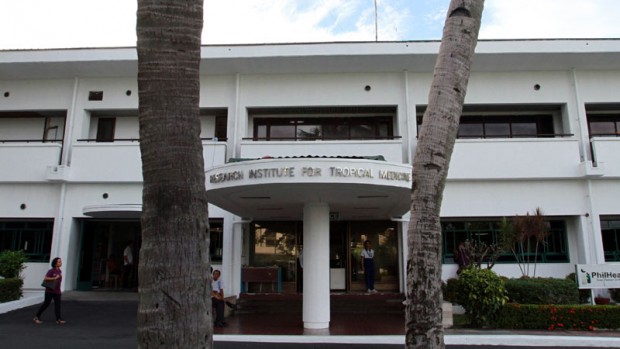Random Zika testing urged

ZIKA TESTING AND TREATMENT CENTER The country’s testing kits for the Zika virus are kept at the Research Institute for Tropical Medicine (RITM) in Alabang, Muntinlupa City. The RITM is the primary health facility in charge of diagnosing and treating patients with emerging infectious diseases. INQUIRER PHOTO
SOME doctors are urging the Department of Health (DOH) to start testing people in barangays with a high incidence of dengue for the Zika virus to gauge the magnitude of the problem in the country.
The main carrier of the Zika virus is the Aedes aegypti mosquito, the same vector for dengue, which is endemic in the Philippines.
Dr. Willie Ong, a cardiologist and a former DOH consultant, on Monday said random testing should be done on at least 100 people in the barangays that registered the highest number of dengue cases last year, with pregnant women and those with fever and rashes as the primary targets.
The DOH last year recorded a total of 200,415 dengue cases nationwide. Most of the cases were in Central Luzon, provinces in Calabarzon (Cavite, Laguna, Batangas, Rizal, Quezon), Metro Manila, the Ilocos Region and Cagayan Valley.
“If one American visiting Luzon could get Zika, then many other Filipinos already have the virus,” Ong said.
Ong called for random testing in barangays a day after the DOH announced that an American woman, who spent four weeks in the Philippines in January, had tested positive for the Zika virus. The woman was the country’s second laboratory-confirmed case of the mosquito-borne disease.
The first documented case of the Zika infection in the Philippines was in Cebu province in 2012—a 15-year-old boy who did not have a travel history.
Unwise, undue panic
The DOH Monday said it would not conduct random testing for the Zika virus in the barangays so it could dedicate the 2,000 diagnostic kits it had received from the US Centers for Disease Control and Prevention (CDC) to those who really needed medical attention.
Health Secretary Janette Garin said it was unwise to test people at random just to know how many had been infected by the virus. First and foremost, this would create undue panic among Filipinos, she pointed out.
“If we test everybody, we will use up all the testing kits that we have and possibly neglect those who really need testing,” Garin said.
“We will do what is recommended, we will do what is good for our people. We will not create panic,” she added.
The testing kits refer to assay reagents and laboratory supplies that are needed for the real-time polymerase chain reaction, a form of molecular diagnostics used in laboratories, according to Dr. Socorro Lupisan, director of the Research Institute for Tropical Medicine (RITM).
Actual number
Ong said random testing in the barangays would bring out the actual number of Filipinos who got infected by the virus, which has been linked to cases of microcephaly, a severe brain defect among newborns, in Brazil and Guillain-Barré syndrome in other countries in Latin America.
“Let us stop closing our eyes to this virus that may harm our babies and people. We are already two months late in testing our people for Zika. Let us not wait any longer,” Ong said. He also posted his call to the DOH on his Facebook page.
Panic button
On the same Facebook post, Dr. Ted Herbosa, a former health undersecretary, agreed with Ong, saying that the World Health Organization “has pressed the panic button” and declared the Zika virus a public health emergency of international concern.
“Unless you know the magnitude of the problem, you can’t solve it. We should study cases that test negative for dengue and chikungunya, and test them for Zika virus,” Herbosa said.
He added that testing three to four persons, who yielded negative results, could not be used to say that the country was Zika-free.
The DOH disclosed that before the CDC issued the alert on the American patient, the RITM tested last month three persons with travel history to areas with active Zika virus transmission and had symptoms of the disease. But all three tested negative for the virus.
Lurking somewhere
Health authorities said the two confirmed cases in the Philippines highly indicated that the virus was lurking somewhere in the country.

Kits at RITM
So far, there are assay reagents enough to test a maximum of 2,000 suspected cases of the Zika virus at the RITM in Muntinlupa City, the primary health facility in charge of diagnosing and treating patients with emerging infectious diseases, Lupisan told the Inquirer in a phone interview.
“We have a partner that will be ready to test in the Visayas. We are also preparing Mindanao to be ready,” Lupisan said.
Garin said the DOH was getting the most reliable testing kit from the CDC through the World Health Organization, as the Zika virus was something new.
“There are companies offering testing kits for sale but we are still checking the reliability, efficiency and sensitivity of these products,” she added.
In a memorandum dated Feb. 7, the CDC said there were no commercially available Food and Drug Administration-cleared diagnostic assays or kits for Zika virus infection in the United States.
Placing more orders
Garin also disclosed that the DOH had been placing orders at the CDC for the testing kits early this year. “Every two weeks we order from them,” she said. But so far, the health agency has been provided with only 2,000 kits.
The DOH has yet to receive from the CDC other pertinent information on the American patient, who was reported to have traveled mostly in Luzon during her stay in the country from Jan. 2 to 28.
Garin said it was important that the DOH be able to trace the whereabouts of the American during her stay in the country so that the health department could take measures against the spread of the virus in those areas.
“Even if we don’t have the information yet, we are persistent with our aggressive surveillance. But we are looking for the exact places where she went so we can document it and we can augment our surveillance,” she said.
Garin reiterated Monday the importance of eliminating the breeding sites of the Aedes aegypti mosquitoes in homes and in the community to prevent the spread of the virus.
She urged pregnant women and those planning to get pregnant to “exercise maximum efforts” to avoid getting bitten by mosquitoes, especially during the day.
She also advised them to transfer to a safer place when a household member exhibits symptoms of the virus, such as fever, rashes, muscle pains and conjunctivitis.
Stay calm
Also Monday, Malacañang called on the public to stay calm amid reports that an American was reported to have contracted the Zika virus.
Presidential Communications Secretary Herminio Coloma Jr. said there was no epidemic or outbreak of the virus as the DOH had confirmed only a single case so far.
“The DOH is prepared in terms of detection, isolation and treatment of those who could possibly be infected by the virus. Hence, the public should stay alert, informed and calm,” said Coloma. With a report from Gil C. Cabacungan